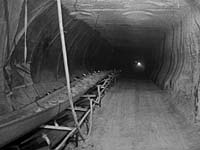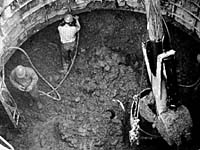Description
Location
Refinery Process
Producers
Uses
Economic Impact
Concerns

Saskatchewan is the world's largest producer of Potash. Several companies operate in the province including Agrium, IMC and the Potash Corporation of Saskatchewan. The largest single producer, by far, is the Potash Corporation of Saskatchewan. Since its privatization in 1989, it has become the world's largest fertilizer enterprise, with net sales exceeding $US 2.3 billion in 1997. Although the corporation produces all major fertilizer nutrients: nitrogen, phosphorus and potash , it dominated the world in Potash production with a total of 6.4 million tonnes in 1997 ( about 23% of the world's capacity). The corporation operates six mines in Saskatchewan plus one in New Brunswick and another in Utah. The Saskatchewan mining area is large covering the major centres of Saskatoon, Regina, Esterhazy and Rocanville. The majority of production (>90%) is exported.
History of PotashPotash is the great success story in Saskatchewan's mining history. In the 1980's, potash topped oil and natural gas as the resource with the greatest value of production. In 1943, a core sample from an exploratory oil well near Radville, Saskatchewan, showed potash at a depth of almost 2 km. Three years later, a core sample from an exploratory well near Unity revealed high-grade potash at a depth of about 1 km. This discovery of potassium-bearing ore at a more accessible depth immediately stimulated great interest on the part of government and industry. Exploration was stepped up over the next few years, and it soon became evident that one of the world's major potash deposits lay beneath southern Saskatchewan. Exploration in the 1950s revealed the existence of huge potash beds underlying most of southern Saskatchewan. The first potash mine in Saskatchewan, owned by the Potash Company of America, was completed in 1958. The mine flooded the same year and did not return to production until 1965. |

The I.M.C. mine at Esterhazy was first to overcome the Blairmore Formation. The mine's shafts had to be sunk through a treacherous 300 foot layer of unconsolidated sand and water about halfway to the potash deposit. A successful technique of freezing this layer until the shaft is dug and sealed in tubbing was developed. This large potash mine (K-1)commenced the first commercial production of potash in 1962 and has been in continuous operation since production started. A second shaft, about 10 km away, was completed by IMC in 1967; the two mines (K-1 & K-2) are connected underground. Another mining operation went into production in 1964, and three more started up in 1968. By 1974, 10 potash mines were operating in Saskatchewan with a total annual production capacity of nearly 13 million tonnes of potassium chloride. With technical difficulties taken care of, other problems involving markets and
politics intervened. Temporary oversupply affected marketing conditions in the late
sixties and involved some cross-border disputes. A taxation problem inhibited the expansion
in the seventies, culminating in the provincial government's acquisition of about half the
productive capacity.
|
